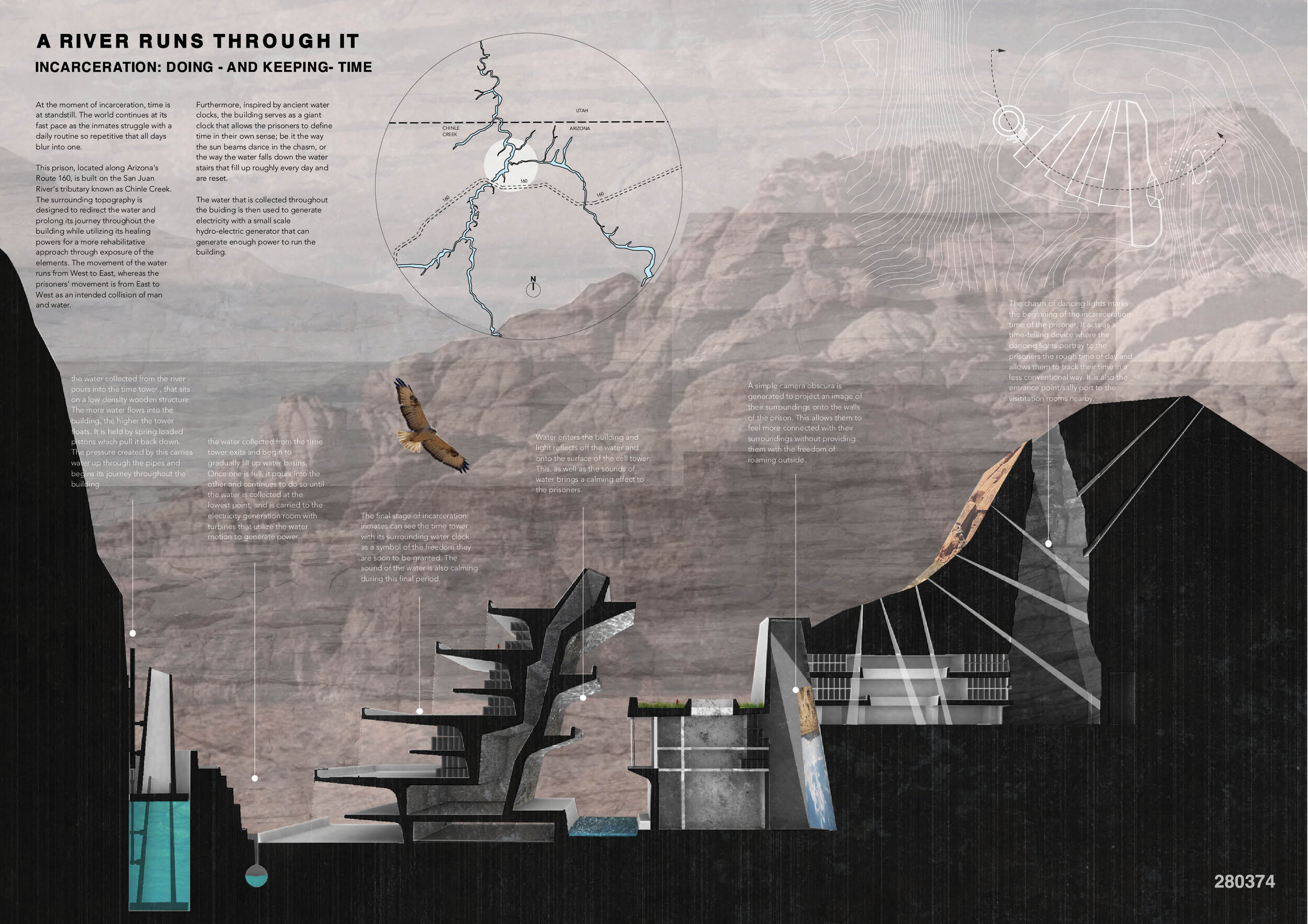
Prison Puzzle (2015-2016)
Brief summary
Is there such a thing as a perfect prison? Is it possible, even in theory, to satisfy needs as potentially contrasting as those of inmates, victims and society? Rather than avoiding prison design on moral grounds, Combo Competitions wants to encourage architects and designers to confront the issue, looking for solutions to a problem that is yet to find a correct answer.
Why aren’t prisons working, and what could be done to lower recidivism numbers? The built environment can have significant impact on its inhabitants, so how can architecture be used to solve the problem?
The goal of Prison Puzzle is to design a medium-security prison complex with a capacity of 500 inmates, located in the desert of Arizona, United States. The concept should address recidivism and how it can be reduced, at the same time considering the different interests and requirements found in inmates, victims as well as society as a whole. Participants are also encouraged to explore how architecture can help in shaping environments that influence behaviors.
Alongside recidivism, there are three main elements to acknowledge concerning imprisonment: inmates, victims and society.
United States is an interesting example as it is home to less than 5% of the world’s population, but houses around 25% of its prisoners. Tougher laws adopted in the 1980’s has resulted in a proportionally large prison population, creating a downward spiral of overcrowded prisons with poor living conditions and little opportunity for rehabilitation. This in turn leads to high rates of recidivism, further burdening an already strained system.
The Prison Puzzle site is located in Arizona, United States - a state where the number of inmates per resident is far above the US average. The site is a large area of land along US Route 160, located in the desert near the Utah border in northern Arizona.
Awarded proposals
1st prize - (proto) Prison by Alex Warr and Zach Walters
JURY’S COMMENTS: (proto) Prison manages to tackle two of the United States’ greatest challenges: incarceration and sustainable energy production. The two very disparate subjects are poetically entwined, moving towards something grander than the sum of its parts. By programmatically blurring the boundaries between prisoners and outside society – and facilitating interaction – the proposal reduces the risk of recidivism while at the same time furthering important research. Conceptually, the inverted panopticon along with the three programmatic rings (cell blocks, research and support) convinces and responds well to the challenges and opportunities offered by the site. The scheme is captivating, not only because of its technical creativity, but also because of the way it addresses the brief with both clarity and ingenuity. The introduction of an alternative energy research facility, directly run in conjunction with the prison, transforms the conventional program of the prison into one that is more related to education, research and innovation. Held together by a straightforward and lucid presentation, (proto) Prison is a well-deserving winner.
2nd prize - To the Moon and Back Again by Lina Aakerøy, Wenzel Mielke, Elias Solberg and Charlotte Hoaas
JURY’S COMMENTS: To the Moon and Back again is a believable and appealingly presented proposal with clear strategy and realistic solutions. By emphasizing prisoner rehabilitation at all stages of the sentence, it offers a considerate and attainable way of reducing recidivism. Well-written text based on contemporary research, accompanied by beautiful illustrations, explain the project in an engaging and convincing manner. With a focus on contact – be it in the form of visits, podcasts or relocation to a transfer building – the proposal ensures a continuous connection to society and therefore a greater chance of reintegration after release. While the absence of radical ideas might be regarded as somewhat humble, the confidence in which the pragmatic solution is told renders To the Moon and Back into a positive and impressive proposal.
3rd Prize - Borderless Prison by Emmanuelle Agustoni, Konstantinos Katsas and Sergio Antonio Torres Escobar
JURY’S COMMENTS: Borderless Prison is a proposal that addresses the main aspects of the competition by successfully combining three essential elements: prison concept, context and design. Here the landscape itself is considered as part of a systemized network of prisons. If, indeed, a prison is to be situated in the desert then should it not be embedded therein? The diagram of the proposal is elementary, convincing, and (although cursory in its visual explanation), well represented. The simplicity of the line strengthens the progressive design as the antithesis of contemporary prisons: here the immensity of the desert becomes the wall for the borderless prison.
Honorable mention - Catharsis by Alžbeta Barančíková
JURY’S COMMENTS: Catharsis offers a spiritual take on the state of the prisoner and his troubled relationship with society. Through careful analysis of human behavior and destiny related to incarceration, the proposal argues for a sentence which is mostly spent off-site, at a carefully chosen location. Although idealistic, it gives purpose to the different stages of a sentence – physically and emotionally. Conceptually strong and beautifully portrayed.
Honorable mention - Plug-In Prison by Michael Macfarlane and Adam Telfer
JURY’S COMMENTS: Like a 21st century spatial interpretation of the initiation rites of the Roman Colosseum – in which prisoners were incarcerated, presented, and played – this rather prophetic and well represented proposal explores a fascinating, if not fundamentally concerning, attitude toward rehabilitation through social engineering and surveillance. By turning physical architecture into a secondary consideration in favor of a virtual environment, Plug-in Prison offers a tailor-made solution for every prisoner in complete isolation mode. Equal parts technological curiosity and social criticism, the proposal stands out by fundamentally rethinking the approach to incarceration.
































